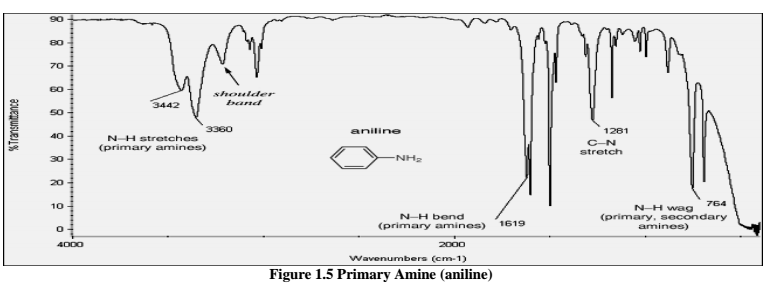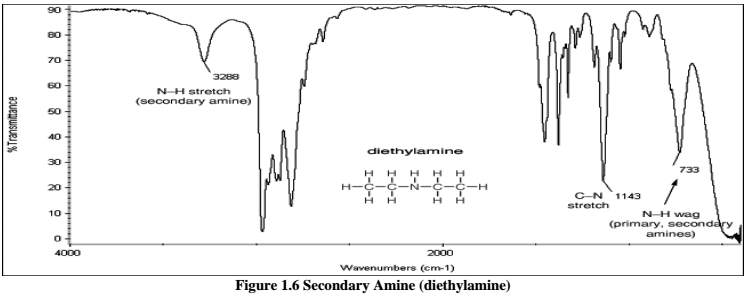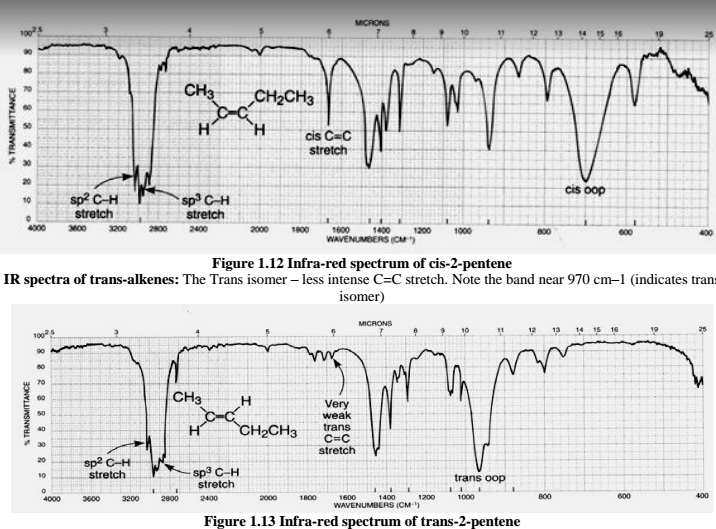Q.2.(c)How will you distinguish
(i) 10,20, and 30 aliphatic amines.
(ii) 10,20,and 30 aliphatic alcohols and phenols.
(iii) Alkane, alkene, alkyne and arene from each other.
[adsense:336x280:8701650588]
(i). Primary amine spectra:The primary amine shows two N–H stretches (3442, 3360); note the shoulder band, which is an overtone of the N–H bending vibration. The C–N stretch appears at 1281 rather than at lower wavenumbers because aniline is an aromatic compound. Also note the N–H bend at 1619.

Secondary amine spectra:The spectrum of diethylamine is shown below. This secondary amine shows only one N–H stretch (3288). The C–N stretch is at 1143, in the range for non-aromatic amines (1250-1020). Diethylamine also showsan N–H wag
 Tertiary amine spectraTriethylamine is a tertiary amine and does not have an N–H stretch, nor an N–H wag. The C–N stretch is at 1214 cm-1 (non-aromatic).
Tertiary amine spectraTriethylamine is a tertiary amine and does not have an N–H stretch, nor an N–H wag. The C–N stretch is at 1214 cm-1 (non-aromatic).

(ii).10,20,and 30 aliphatic alcohols and phenols
Hydrogen-bonded O-H stretching occurs as a very broad and intense peak at 3400-3300 cm-1 Free O-H stretching (only observed when dilute) occurs at3600 – 3650 cm-1
C-O-H bending - a broad and weak peak at 1550-1220 cm-1
C-O stretching occurs in range 1260 – 1000 cm-1
The position of the C-O stretch can be used to determine the type of alcohol
Phenols – 1220 cm-1
Tertiary alcohols – 1150 cm-1
Secondary alcohols – 1100 cm-1
Primary alcohols – 1050 cm-1
Primary alcohol spectra:
Secondaryalcoholspectra:

Phenol spectra:

(iii). IR Spectra of alkanes: C-H stretch occurs at 3000 – 2840 cm-1
CH2 bending modes at 1465 cm-1
CH3 bending absorption at 1375 cm-1
CH2 (four or more CH2 groups) rocking at 720 cm-1

IR Spectra of alkene:The strength of the C=C stretch can serve to differentiate between cis and trans isomers Cis-alkenes: The cis isomer – more intense C=C stretch.Note the single large peak at 700 cm-1 (indicates cis isomer)

IR spectra of alkynes: C-H stretching frequency is approximately 3300 cm-1 (still higher than for alkanes or alkenes) C-C stretch occurs at approximately 2150 cm-1 (but not observed if alkyne is symmetric)

Arenes:
C-H stretch occurs between 3050 and 3010 cm-1
C-H out-of-plane bending occurs at 900 – 690 cm-1
(Useful for determining type of ring substitution)
C=C stretching often occurs in pairs at 1600 cm-1 and 1475 cm-1
Overtone and combination bands occur between 2000 and 1667 cm-1
Monosubstituted rings give strong absorptions at 690 cm-1 and 750 cm-1 (second may be masked by hydrocarbon solvent)











